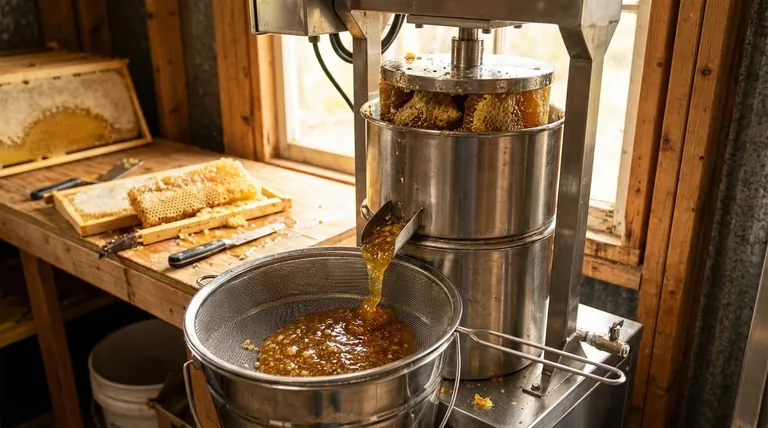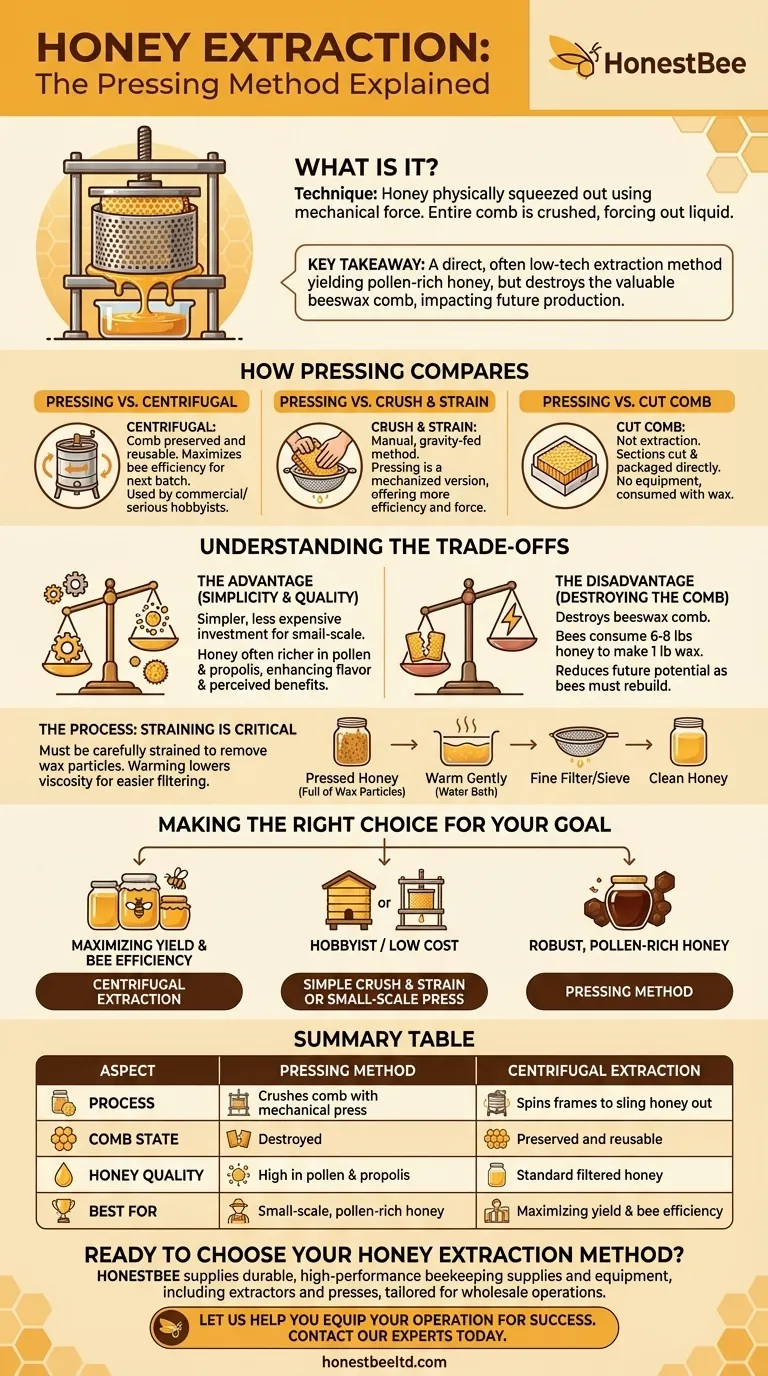To put it simply, the pressing honey method is a technique where honey is physically squeezed out of the honeycomb using a mechanical press. Unlike more common methods that use centrifugal force, this approach crushes the entire comb to force the liquid honey out. After pressing, the honey is typically warmed slightly and strained to remove wax particles and other debris.
Pressing is a direct and often low-tech method of honey extraction that yields a product rich in pollen, but at the cost of destroying the beeswax comb, which can impact future honey production.

How Pressing Compares to Other Methods
Understanding honey pressing requires seeing it in context with the other primary extraction techniques. Each method serves a different purpose and reflects a different philosophy of beekeeping.
Pressing vs. Centrifugal Extraction
The most common method for commercial and serious hobbyist beekeepers is centrifugal extraction. In this process, the wax cappings are removed from the comb, and the frame is spun in an extractor. The force slings the honey out of the cells without damaging the underlying comb structure.
The key difference is the preservation of the comb. Bees expend a tremendous amount of energy to produce wax and build comb. By returning the empty comb to the hive, beekeepers give the colony a massive head start on storing the next batch of honey. Pressing destroys this valuable resource, forcing the bees to rebuild from scratch.
Pressing vs. Crush and Strain
The pressing method is essentially a more mechanized version of the crush and strain technique. In a simple crush and strain setup, the beekeeper mashes the honeycomb by hand and allows the honey to drip through a filter or cheesecloth, aided only by gravity.
A honey press introduces mechanical force, allowing the beekeeper to extract more honey more efficiently than a simple gravity-fed system.
Pressing vs. Cut Comb
Cut comb is not an extraction method at all. Instead, it involves cutting sections of the honeycomb and packaging them directly for sale. The consumer eats the honey, wax, and all. This method is for producing a specific final product and bypasses the need for extraction equipment entirely.
Understanding the Trade-offs
Choosing an extraction method involves balancing efficiency, cost, and the impact on your bees. The pressing method comes with a distinct set of pros and cons.
The Advantage: Simplicity and Quality
For small-scale beekeepers, a honey press can be a simpler and less expensive investment than a centrifugal extractor. Furthermore, because the entire comb is crushed, the resulting honey often contains a higher concentration of pollen and propolis, which can enhance its flavor, color, and perceived health benefits.
The Disadvantage: Destroying the Comb
The primary drawback is the destruction of the beeswax comb. It is estimated that bees consume 6-8 pounds of honey to produce just one pound of wax. By destroying the comb, you are essentially reducing the colony's potential for future honey production, as they must divert resources to rebuilding.
The Process: Straining is Critical
Honey that has been pressed is full of wax particles. It must be carefully strained to be palatable. This often involves gently warming the honey in a water bath to lower its viscosity, making it easier to pour through a series of fine filters or sieves.
Making the Right Choice for Your Goal
The best method depends entirely on your resources, scale, and beekeeping philosophy.
- If your primary focus is maximizing honey yield and bee efficiency: Centrifugal extraction is the superior choice because it preserves the essential beeswax comb.
- If you are a hobbyist with only one or two hives: A simple crush and strain or a small-scale press offers a low-cost way to get your honey without investing in expensive equipment.
- If your priority is producing a robust, pollen-rich honey: The pressing method can deliver a unique, high-quality product that many consumers seek out.
Ultimately, choosing your extraction technique is about aligning your equipment and process with your specific beekeeping goals.
Summary Table:
| Aspect | Pressing Method | Centrifugal Extraction |
|---|---|---|
| Process | Crushes comb with mechanical press | Spins frames to sling honey out |
| Comb State | Destroyed | Preserved and reusable |
| Honey Quality | High in pollen & propolis | Standard filtered honey |
| Best For | Small-scale beekeepers, pollen-rich honey | Maximizing yield & bee efficiency |
Ready to Choose Your Honey Extraction Method?
Whether you're a commercial apiary focused on maximizing yield or a distributor supplying beekeepers, having the right equipment is key to achieving your goals. HONESTBEE supplies durable, high-performance beekeeping supplies and equipment, including extractors and presses, tailored for wholesale operations.
Let us help you equip your operation for success. Contact our experts today to discuss the best solutions for your specific needs.
Visual Guide

Related Products
- Electric Honey Press Machine for Squeezing Honey Comb Press Equipment
- Easy Use Manual Stainless Steel Honey Press for Honey Comb
- 10L Stainless Steel Electric Honey Press Machine
- Stainless Steel Manual Honey Press with Guard for Pressing Honey and Wax
- Stainless Steel Honey Press Wax Press with Tank
People Also Ask
- What are the reasons for choosing a honey press over a dedicated honey extractor? Maximize Disease Control and Natural Beekeeping
- Why are honey presses particularly useful for beekeepers using Top Bar hives? Maximize Your Harvest
- What are the unique characteristics of honey presses? Maximize Honey Yield for Small-Scale Beekeeping
- How does using a honey press affect honeycomb reuse? It Destroys Comb but Captures Unique Honey & Wax
- How can the honey press be cleaned after use? A Step-by-Step Guide for Commercial Beekeepers



















